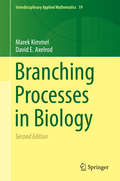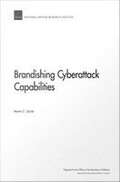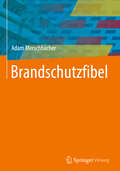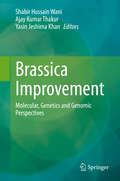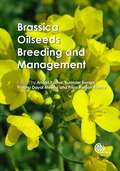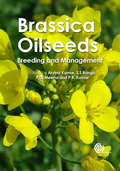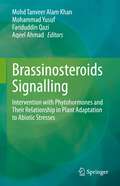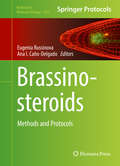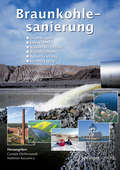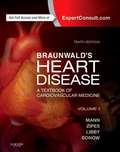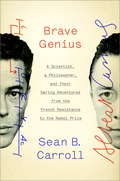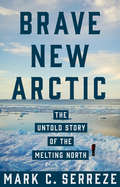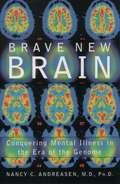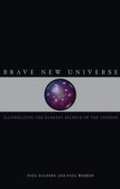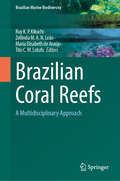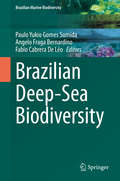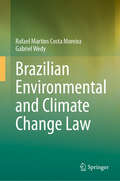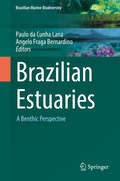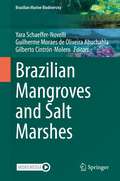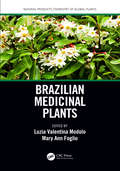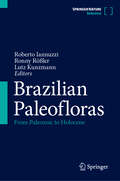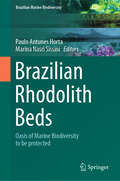- Table View
- List View
Branching Processes in Biology (Interdisciplinary Applied Mathematics #19)
by Marek Kimmel David E. AxelrodThis book provides a theoretical background of branching processes and discusses their biological applications. Branching processes are a well-developed and powerful set of tools in the field of applied probability. The range of applications considered includes molecular biology, cellular biology, human evolution and medicine. The branching processes discussed include Galton-Watson, Markov, Bellman-Harris, Multitype, and General Processes. As an aid to understanding specific examples, two introductory chapters, and two glossaries are included that provide background material in mathematics and in biology. The book will be of interest to scientists who work in quantitative modeling of biological systems, particularly probabilists, mathematical biologists, biostatisticians, cell biologists, molecular biologists, and bioinformaticians. The authors are a mathematician and cell biologist who have collaborated for more than a decade in the field of branching processes in biology for this new edition. This second expanded edition adds new material published during the last decade, with nearly 200 new references. More material has been added on infinitely-dimensional multitype processes, including the infinitely-dimensional linear-fractional case. Hypergeometric function treatment of the special case of the Griffiths-Pakes infinite allele branching process has also been added. There are additional applications of recent molecular processes and connections with systems biology are explored, and a new chapter on genealogies of branching processes and their applications. Reviews of First Edition: "This is a significant book on applications of branching processes in biology, and it is highly recommended for those readers who are interested in the application and development of stochastic models, particularly those with interests in cellular and molecular biology. " (Siam Review, Vol. 45 (2), 2003) "This book will be very interesting and useful for mathematicians, statisticians and biologists as well, and especially for researchers developing mathematical methods in biology, medicine and other natural sciences. " (Short Book Reviews of the ISI, Vol. 23 (2), 2003)
Brand Seduction: How Neuroscience Can Help Marketers Build Memorable Brands
by Daryl WeberAn examination of the nature of brands, how they exist and behave in the mind, and how marketers and business leaders can use this to their advantage.In Brand Seduction, author Daryl Weber reveals the latest psychological and neuroscientific discoveries about how our minds process brand information and makes decisions, and the important roles our emotions and unconscious play in our selections.Through simple language, engaging stories, and real-world examples, Brand Seduction shows you how to decode, build, and use these hidden brand fantasies to grow your brand and business.Praise for Brand Seduction“Powerful, profound, and beautifully written, Brand Seduction raises the bar for every marketer to do work that truly matters.” —Seth Godin, author of All Marketers Are Liars“Clever, creative, and jam-packed with useful insights, Brand Seduction shows how our brain secretly shapes our choices in ways we may never have realized.” —Jonah Berger, Wharton Professor and bestselling author of Contagious and Invisible Influence“With solid research and real-world examples, Daryl Weber makes the science of marketing inspiring and actionable. Brand Seduction is a valuable tool for anyone seeking to leverage the power of their brands.” —Nir Eyal, author of Hooked
Brandishing Cyberattack Capabilities
by Martin C. LibickiDeterrence is possible only when others have at least a good idea of possible U.S. military reprisals, but cyberattack capabilities resist such demonstration. This report explores ways they can be and under what circumstances, then goes on to examine the difficulties and the drawbacks. Such "brandishing" is no panacea and could even backfire if misinterpreted. Its success also relies on the strength of other elements of the deterrence posture.
Brandschutzfibel
by Adam MerschbacherDie „Brandschutzfibel“ wird dem Fachmann für Brandschutz, dem interessierten Laien und den Beratern in Versicherungen, den Feuerwehren, sowie Herstellern in der Planung künftiger Brandschutzprodukte einen fundierten Überblick über wirkungsvolle und sinnvolle Brandschutzmaßnahmen im privaten und vor allem gewerblichen Umfeld geben. Das Wort „Gewerbe“ soll, auch wenn es nicht immer passend ist, für Unternehmen, Ladengeschäfte, Banken, Kirchen, Behörden, Museen, ja sogar für einen Zirkus und den Tierpark stehen. Dabei spielt die Größe überhaupt keine Rolle. Die Brandschutzrichtlinien gelten für die Würstelbude ebenso wie für größte Industrieunternehmen, in jeweils angepasster Form.
Brandschutzfibel
by Adam MerschbacherDie „Brandschutzfibel“ wird dem Fachmann für Brandschutz, dem interessierten Laien und den Beratern in Versicherungen, den Feuerwehren, sowie Herstellern in der Planung künftiger Brandschutzprodukte einen fundierten Überblick über wirkungsvolle und sinnvolle Brandschutzmaßnahmen im privaten und vor allem gewerblichen Umfeld geben. Das Wort „Gewerbe“ soll, auch wenn es nicht immer passend ist, für Unternehmen, Ladengeschäfte, Banken, Kirchen, Behörden, Museen, ja sogar für einen Zirkus und den Tierpark stehen. Dabei spielt die Größe überhaupt keine Rolle. Die Brandschutzrichtlinien gelten für die Würstelbude ebenso wie für größte Industrieunternehmen, in jeweils angepasster Form.
Brassica Improvement: Molecular, Genetics and Genomic Perspectives
by Shabir Hussain Wani Ajay Kumar Thakur Yasin Jeshima KhanGlobal population is mounting at an alarming stride to surpass 9.3 billion by 2050, whereas simultaneously the agricultural productivity is gravely affected by climate changes resulting in increased biotic and abiotic stresses. The genus Brassica belongs to the mustard family whose members are known as cruciferous vegetables, cabbages or mustard plants. Rapeseed-mustard is world’s third most important source of edible oil after soybean and oil palm. It has worldwide acceptance owing to its rare combination of health promoting factors. It has very low levels of saturated fatty acids which make it the healthiest edible oil that is commonly available. Apart from this, it is rich in antioxidants by virtue of tocopherols and phytosterols presence in the oil. The high omega 3 content reduces the risk of atherosclerosis/heart attack. Conventional breeding methods have met with limited success in Brassica because yield and stress resilience are polygenic traits and are greatly influenced by environment. Therefore, it is imperative to accelerate the efforts to unravel the biochemical, physiological and molecular mechanisms underlying yield, quality and tolerance towards biotic and abiotic stresses in Brassica. To exploit its fullest potential, systematic efforts are needed to unlock the genetic information for new germplasms that tolerate initial and terminal state heat coupled with moisture stress. For instance, wild relatives may be exploited in developing introgressed and resynthesized lines with desirable attributes. Exploitation of heterosis is another important area which can be achieved by introducing transgenics to raise stable CMS lines. Doubled haploid breeding and marker assisted selection should be employed along with conventional breeding. Breeding programmes aim at enhancing resource use efficiency, especially nutrient and water as well as adoption to aberrant environmental changes should also be considered. Biotechnological interventions are essential for altering the biosynthetic pathways for developing high oleic and low linolenic lines. Accordingly, tools such as microspore and ovule culture, embryo rescue, isolation of trait specific genes especially for aphid, Sclerotinia and alternaria blight resistance, etc. along with identification of potential lines based on genetic diversity can assist ongoing breeding programmes. In this book, we highlight the recent molecular, genetic and genomic interventions made to achieve crop improvement in terms of yield increase, quality and stress tolerance in Brassica, with a special emphasis in Rapeseed-mustard.
Brassica Oilseeds- Breeding and Mnaagement
by Priya Priya Arvind Kumar Surinder S Banga Prabhu PrabhuOilseed brassicas are among the largest traded agricultural commodities and are grown in around fifty countries worldwide. Utilised for both consumption and bioenergy use, demand is increasing and this book covers the entire gamut of oilseed brassicas. Beginning with an introduction and then organised into two sections, it reviews genetics and genomics (including breeding, heterosis and selection methods) and stress management and important pathogens, to provide a complete overview of brassica oilseeds.
Brassica Oilseeds: Breeding and Management
by Arvind KumarOilseed brassicas are among the largest traded agricultural commodities and are grown in around fifty countries worldwide. Utilised for both consumption and bioenergy use, demand is increasing and this book covers the entire gamut of oilseed brassicas. Beginning with an introduction and then organised into two sections, it reviews genetics and genomics (including breeding, heterosis and selection methods) and stress management and important pathogens, to provide a complete overview of brassica oilseeds.
Brassinosteroids Signalling: Intervention with Phytohormones and Their Relationship in Plant Adaptation to Abiotic Stresses
by Mohammad Yusuf Mohd Tanveer Alam Khan Fariduddin Qazi Aqeel AhmadThis book presents the state of the skill of understanding brassinosteroids (BRs) signaling plus crosstalk with phytohormone and their association in plant adaptation to abiotic stresses comprising physiological, biochemical, and molecular developments. Due to progressively adverse environmental conditions and scarce natural resources, high-efficient crops have become more important than ever. For the successful improvement of stress-tolerant plants, it is vital to understand the precise signaling appliances that plants practice to abide stresses as well as how much these mechanisms are convinced by phytohormone. However, it is also debatable on which step plants can attain brassinosteroids (BRs) signaling from an evolutionary viewpoint. BRs are involved in modulating a large array of important functions throughout a plant’s life cycles. BRs are considered as one of the most important plant steroidal hormones that show a varied role in observing a wide range of developmental practices in plants. Our grip on brassinosteroids signaling has quickly extended over the past two decades, owing in part to the isolation of the constituents intricate in the signal transduction trail. The book proposes a useful guide for plant researchers and graduate students in connected areas.
Brassinosteroids: Methods and Protocols (Methods in Molecular Biology #1564)
by Eugenia Russinova Ana I. Caño-DelgadoThis detailed volume compiles state-of-the-art methodologies for the study of brassinosteroid hormones, contributed by recognized researchers in the field, in order to bring together different experimental and theoretical biology techniques for addressing the questions of how brassinosteroids function in Arabidopsis and other agriculturally valuable species, such as rice and sorghum. Written for the highly successful Methods in Molecular Biology series, chapters include introductions to their respective topics, lists of the necessary materials and reagents, step-by-step, readily reproducible laboratory protocols, and tips on troubleshooting and avoiding known pitfalls. Authoritative and practical, Brassinosteroids: Methods and Protocols assesses a wide range of appealing methodologies for experts as well as researchers with a general interest in hormone signaling in plants.
Braunkohlesanierung: Grundlagen, Geotechnik, Wasserwirtschaft, Brachflächen, Rekultivierung, Vermarktung
by Carsten Drebenstedt Mahmut KuyumcuAllein im Raum Halle/Leipzig und der Lausitz wurden etwa 30 Braunkohlentagebaue und 90 Kraftwerks- und Veredlungsstandorte seit Anfang der 1990er Jahre saniert mit dem Ziel, Umweltsch#65533;den zu beseitigen und die Landschaft wiederherzustellen. Vertreter aus Beh#65533;rden und Hochschulen, Sanierungsunternehmen und Planungsb#65533;ros erl#65533;utern die eigens daf#65533;r entwickelten Technologien, sie beschreiben die Managementstrukturen und ihre Erfahrungen bei der Sanierung des stillgelegten Braunkohlenbergbaus. Mit zahlreichen Abbildungen und Tabellen sowie einem Glossar.
Braunwald's Heart Disease: A Textbook of Cardiovascular Medicine (Volume #1)
by Douglas L. Mann Douglas P. Zipes Peter Libby Robert O. Bonow Eugene BraunwaldVolume 1 of the two-part textbook.
Brave Genius
by Sean B. CarrollThe never-before-told account of the intersection of some of the most insightful minds of the 20th century, and a fascinating look at how war, resistance, and friendship can catalyze genius. In the spring of 1940, the aspiring but unknown writer Albert Camus and budding scientist Jacques Monod were quietly pursuing ordinary, separate lives in Paris. After the German invasion and occupation of France, each joined the Resistance to help liberate the country from the Nazis, ascended to prominent, dangerous roles, and were very lucky to survive. After the war and through twists of circumstance, they became friends, and through their passionate determination and rare talent they emerged as leading voices of modern literature and biology, each receiving the Nobel Prize in their respective fields. Drawing upon a wealth of previously unpublished and unknown material gathered over several years of research, Brave Genius tells the story of how each man endured the most terrible episode of the twentieth century and then blossomed into extraordinarily creative and engaged individuals. It is a story of the transformation of ordinary lives into exceptional lives by extraordinary events--of courage in the face of overwhelming adversity, the flowering of creative genius, deep friendship, and of profound concern for and insight into the human condition.
Brave New Arctic: The Untold Story of the Melting North (Science Essentials)
by Mark C. SerrezeAn insider account of how researchers unraveled the mystery of the thawing ArcticIn the 1990s, researchers in the Arctic noticed that floating summer sea ice had begun receding. This was accompanied by shifts in ocean circulation and unexpected changes in weather patterns throughout the world. The Arctic's perennially frozen ground, known as permafrost, was warming, and treeless tundra was being overtaken by shrubs. What was going on? Brave New Arctic is Mark Serreze's riveting firsthand account of how scientists from around the globe came together to find answers.In a sweeping tale of discovery spanning three decades, Serreze describes how puzzlement turned to concern and astonishment as researchers came to understand that the Arctic of old was quickly disappearing--with potentially devastating implications for the entire planet. Serreze is a world-renowned Arctic geographer and climatologist who has conducted fieldwork on ice caps, glaciers, sea ice, and tundra in the Canadian and Alaskan Arctic. In this must-read book, he blends invaluable insights from his own career with those of other pioneering scientists who, together, ushered in an exciting new age of Arctic exploration. Along the way, he accessibly describes the cutting-edge science that led to the alarming conclusion that the Arctic is rapidly thawing due to climate change, that humans are to blame, and that the global consequences are immense.A gripping scientific adventure story, Brave New Arctic shows how the Arctic's extraordinary transformation serves as a harbinger of things to come if we fail to meet the challenge posed by a warming Earth.
Brave New Brain: Conquering Mental Illness in the Era of the Genome
by Nancy C. AndreasenHere, leading neuroscientist Nancy Andreasen offers a state-of-the-art look at what we know about the human brain and the human genome--and shows how these two vast branches of knowledge are coming together in a boldly ambitious effort to conquer mental illness. Andreasen gives us an engaging and readable description of how it all works---from billions of neurons, to the tiny thalamus, to the moral monitor in our prefrontal cortex. She shows the progress made in mapping the human genome, whose 30,000 to 40,000 genes are almost all active in the brain. Weread gripping stories of the people who develop mental illness, the friends and relatives who share their suffering, the physicians who treat them, and the scientists who study them so that better treatments can be found. Four major disorders are covered--schizophrenia, manic depression, anxietydisorders, and dementia--revealing what causes them and how they affect the mind and brain. Finally, the book shows how the powerful tools of genetics and neuroscience will be combined during the next decades to build healthier brains and minds. By revealing how combining genome mapping with brain mapping can unlock the mysteries of mental illness, Andreasen offers a remarkably fresh perspective on these devastating diseases.
Brave New Girl
by Rachel Vincent“Thrilling and dangerous, with an ending that will leave you gasping!” —SUZANNE YOUNG, New York Times bestselling author of the series THE PROGRAMIn a world where everyone is the same, one girl is the unthinkable: unique. A high-stakes fast-paced series launch from New York Times bestselling author Rachel Vincent. We have brown hair. Brown eyes. Fair skin. We are healthy and strong and smart. But only one of us has ever had a secret. Dahlia 16 sees her face in every crowd. She’s nothing special—just one of five thousand girls created from a single genome to work for the greater good of the city. Meeting Trigger 17 changes everything. He thinks she’s interesting. Beautiful. Unique. Which means he must be flawed. When Dahlia can’t stop thinking about him—when she can’t resist looking for him, even though that means breaking the rules—she realizes she’s flawed, too. But if she’s flawed, then so are all her identicals. And any genome found to be flawed will be recalled. Destroyed. Getting caught with Trigger would seal not only Dahlia’s fate, but that of all five thousand girls who share her face. But what if Trigger is right? What if Dahlia is different? Suddenly the girl who always follows the rules is breaking them, one by one by one. . . . ** Praise for Rachel Vincent’s The Stars Never Rise “This high-stakes, romantic thriller had me hooked from the very first page!” —Kimberly Derting, author of the Taking trilogy “Un-put-down-able.” —Kirkus Reviews “A hugely fun and entertaining read.” —SLJ “Vincent (the Soul Screamers series) carves out an intriguing niche in the post-apocalyptic landscape . . . plenty of reasons for readers to look forward to the next installment.” —PW“The gritty world is compellingly presented . . . much to consider.” —The Bulletin “A devil of a thriller.” —Booklist
Brave New Universe: Illuminating The Darkest Secrets Of The Cosmos
by Paul Halpern Paul WessonCosmologists yearn to behold the unseen elements of our universe. And as new technologies become more powerful and precise, scientists are getting their wish—though these tools are challenging the limits of our imagination as fast as they are answering many longstanding questions. Space is one of the last great frontiers for modern man. A never-ending source of investigation and inspiration, it beckons to scientists with an irresistible siren’s call. And in this glorious age of cosmology, astronomical measurement has never been more precise. The power provided to us by extraordinary new observational mechanisms has shattered former suppositions and stimulated exciting new visions of the universe. Using modern instruments such as the Wilkinson Microwave Anisotropy Probe (WMAP), astronomers now have access to information about the age and composition of the universe. By providing greatly improved answers, high-resolution satellite data and novel telescopic techniques have transformed one of science’s most speculative fields into a triumph of meticulous and rigorous detection. Yet as the technological tools grow increasingly robust and we are able to see farther and know more, we find that we have even more questions. Could there be realms beyond ordinary space? Might time, space, and matter simply be illusions? What unique blend of cosmological factors influences life on Earth? Featuring interviews with leaders in the field as well as thought-provoking descriptions of their work, Brave New Universe is a guided tour of current advances and controversies in cosmology.
Brazilian Coral Reefs: A Multidisciplinary Approach (Brazilian Marine Biodiversity)
by Ruy K. P. Kikuchi Maria Elisabeth de Araújo Zelinda M. A. N. Leão Tito M. C. LotufoThe Brazilian coral reefs form structures significantly different from the well-known reef models, as follows: they have a growth form of mushroom-shaped coral pinnacles called "chapeirões"; they are built by a low diversity coral fauna rich in endemic species, with most of them relic forms dating back to the Miocene; and the nearshore bank reefs are surrounded by siliciclastic sediments. The reefs are distributed into four major sectors along the Brazilian coast: the northern, the northeastern, and the eastern regions, and the oceanic islands, but certain isolated coral species can be found in warmer waters in the embayment of the southern region. There are different types of bank reefs, fringing reefs, isolated "chapeirões" and an atoll present along the Brazilian coast. Corals, milleporids, and coralline algae build the rigid frame of the reefs. The areas in which the major coral reefs occur correspond to regions in which nearby urban centers are experiencing accelerated growth, and tourism development is rapidly increasing. The major human effects on the reef ecosystem are mostly associated with the increased sedimentation due to the removal of the Atlantic rainforest and the disposal of industrial and urban effluents. Fishing resources are seriously declining due to pollution and overfishing, and this reduction impacts artisanal fishers, who are impoverished and face food security risks. The effects of warming oceanic waters that have been affecting several reef areas with high-intensity coral bleaching did not show until the 2010 event, episodes of coral mass mortality in Brazilian reefs. However, since 2016, bleaching has increased, as has the mortality of milleporids. There are opportunities to develop purposeful biotechnologies that can support coral reef restoration and conservation. Reciprocally, preserved coral reef ecosystems containing peculiar genetic resources allow biotechnological opportunities to provide products and processes for economically and ecologically prosperous societies.
Brazilian Deep-Sea Biodiversity (Brazilian Marine Biodiversity)
by Angelo Fraga Bernardino Paulo Yukio Gomes Sumida Fabio Cabrera De LéoThis book presents the biodiversity of the Brazilian deep-sea and its many unique geological and biological features, as well as a review of its ecology, conservation, and future research needs. The deep-sea Brazilian margin has an incredible geological heterogeneity with numerous characteristic seafloor features, and latitudinal changes in marine productivity, oceanographic conditions and biological communities have resulted in very distinct biological assemblages at regional and bathymetric scales. It is a tremendously rich ecosystem in terms of living species, from which many well-known historical tales have originated, and with unique importance for the global climate and humanity. Nevertheless, vast areas of the Brazilian margin have been explored for fishing, oil and gas, and other commodities, likely impacting a variety of deep-sea habitats at scales and intensities yet undetermined. This book is intended for students, scholars, professionals and a wide audience interested in the deep-sea in general and, more specifically, in the South Atlantic deep-sea.
Brazilian Environmental and Climate Change Law
by Rafael Martins Costa Moreira Gabriel WedyThe book covers a range of topics including the historical evolution and present landscape of Brazilian environmental law; fundamental principles of environmental law; environmental constitutionalism in Brazil; the legal framework governing environmental assets; animal protection and rights; environmental federalism; national environmental policy; administrative tools for environmental regulation; civil and criminal environmental liability; judicial interpretations of environmental law; specially protected areas; climate change legislation and litigation; and water resource management. This book is intended for those interested in Brazilian environmental and climate change law, specifically catering to students, lawyers, jurists, scholars, and anyone eager to grasp the key aspects and current status of this field. With the international focus on Brazil as a 'continental Country' and the limited availability of English literature on the subject, compounded by the challenges many non-Portuguese speaking academics encounter, this book serves as a comprehensive resource for understanding how Brazil's legal and justice systems address environmental issues.
Brazilian Estuaries: A Benthic Perspective (Brazilian Marine Biodiversity)
by Paulo Da Lana Angelo Fraga BernardinoThis book presents the main drivers of benthic structure and processes in estuaries from the 8,000 km-Brazilian coast, assesses the influence of natural and human disturbance, and discusses their ecological importance and management needs. Estuaries are unique coastal ecosystems often with low biodiversity that sustain and provide essential ecological services to mankind. These ecosystems include a variety of habitats with their own sediment and fauna dynamics, all of them globally altered or threatened by human activities. Mangroves, saltmarshes, tidal flats and other confined estuarine systems are under increasing stress by overfishing and other human activities leading to habitat and species loss. Combined changes in estuarine hydromorphology and in climate pose severe threats to estuarine ecosystems at a global scale.
Brazilian Mangroves and Salt Marshes (Brazilian Marine Biodiversity)
by Yara Schaeffer-Novelli Guilherme Moraes de Oliveira Abuchahla Gilberto Cintrón-MoleroThis book offers a new ecosystemic approach to the understanding of mangrove and salt marsh ecosystems. Brazil has one of the largest areas of mangroves in the world, where salt marshes might or might not be associated. Different landscapes comprise the extensive coastline, where mangrove and salt marsh species’ composition is discussed through the analysis of physiography, zonation, and succession processes. Both salt marsh and mangrove plants and the associated macroalgae will be characterized in their ecophysiological and phenological aspects, as well as genetic and epigenetic diversity. The chapters on microbial diversity and litterfall expose the well-known importance of these ecosystems as highly productive carbon sinks and pumps. The associated fauna of invertebrates (benthic meio and macrofaunas, especially brachyuran crabs) and vertebrates (fishes, birds, and mammals) are presented in a special section. The conservational approach encompasses issues, such as historical ecology, economic valuation, protected areas, environmental education, climate changes, and adaptive management.
Brazilian Medicinal Plants (Natural Products Chemistry of Global Plants)
by Luzia V. Modolo Mary Ann FoglioThe vast and exciting Brazilian flora biodiversity is still underexplored. Several research groups are devoted to the study of the chemical structure richness found in the different Biomes. This volume presents a comprehensive account of the research collated on natural products produced from Brazilian medicinal plants and focuses on various aspects of the field. The authors describe the key natural products and their extracts with emphasis upon sources, an appreciation of these complex molecules and applications in science. Many of the extracts are today associated with important drugs, nutrition products, beverages, perfumes, cosmetics and pigments, and these are highlighted. Key Features: Presents Brazilian biodiversity: its flora, its people, and its research Describes the emergence of natural products research in Brazil Emphasizes the increasing global interests in botanical drugs Aids the international natural product communities to better understand the herbal resources in Brazil Discusses Brazilian legislation to work with native plants
Brazilian Paleofloras: From Paleozoic to Holocene
by Roberto Iannuzzi Ronny Rößler Lutz KunzmannThis book will cover the entire evolutionary history that the terrestrial plants have recorded in Brazilian sedimentary rocks, ranging from the first vestiges of terrestrial environments colonization about 400 million years ago, until reaching the eve of the present time, when the current vegetation formations were organizing to reach their current distribution, diversity and structure in modern biomes. At present Brazil is home to the world's greatest plant biodiversity and we aim to offer here an opportunity to appreciate how this floral biodiversity originated and developed in these lowlands of South America, through chapters elaborated by the best Brazilian paleobotanist and palynologists in collaboration with foreign experts who dedicate to elucidate the evolution of the ancient flora in this part of the planet.
Brazilian Rhodolith Beds: Oasis of Marine Biodiversity to be protected (Brazilian Marine Biodiversity)
by Paulo Antunes Horta Marina Nasri SissiniRhodolith beds form biogenic reefs, oases of high biodiversity in sedimentary seabed environments. The rhodoliths are foundation species, which provide shelter and substrata for important and abundant benthic communities. Currently they have been recognized as an important player to the carbon balance, contributing to the planetarium climatic equilibrium. In Brazil, these environments are frequent and abundant and can be major carbonate ‘factories’ with a key role in the biogeochemical cycling of carbon in the South Atlantic Ocean. However, these organisms and environments are under threat from climate change, particularly ocean acidification and global warming, as well as local stressors such as fishing impacts and coastal run-off. In our book, written by dozens of researchers from different regions and expertise, you will dive more deeply in these and many other subjects related to this wonderful and vulnerable pink and dynamic underwater ecosystems.
